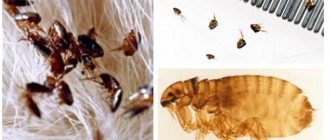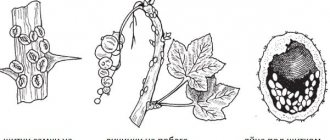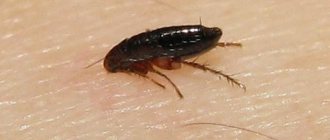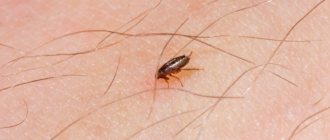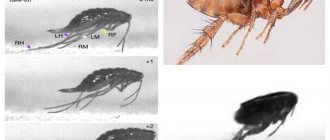Like other warm-blooded animals, cats are susceptible to attack by various parasites that remain on the surface of their body. Among these pests are fleas. These insects feed on cat blood and breed in the fur. Fleas are transmitted from cats to humans in several cases. For example, this can happen if a pet has the parasite Pulex irritans (cat flea).
In some cases, fleas from animals can spread to humans
General information about fleas
Fleas (Siphonaptera) are an order of blood-sucking insects. Currently, entomologists have described 2086 species. They are found everywhere (found even in Antarctica), but are most widespread in countries with temperate and subtropical climates (East and Central Asia, Western America, East Africa). There are 524 species of parasites living in Russia.
When a flea settles on the body of birds and mammals, it begins to actively reproduce and constantly bite through the skin to gain access to the blood, which it feeds on. This causes severe discomfort (itching) in the owner.
The peculiarity of fleas is that different species have some differences in the structure of the oral apparatus and the composition of the enzymes responsible for processing the blood absorbed by the insect. That is why they are divided depending on which hosts they prefer to settle on. Fleas of the species Ctenocephalides felis choose cats as a source of food.
The cat flea Ctenocephalides felis is very small, its body size is from 0.75 to 5 mm
cat flea
The insects Ctenocephalides felis have a number of features. For example, the cat flea is an expert in jumping and the ability to carry weights. It has been proven that this type of parasite can easily pull a load that will exceed their own weight by 130 times. And they jump to a height that exceeds their height by 150 times.
Fleas are not used to fasting - their feeding schedule is 10–15 times a day; without access to blood, the parasite can survive for a maximum of two days
One can also envy the endurance of the insect. For example, it easily makes more than 3,000 jumps in a row. The flea is not afraid of temperature tests. In severe frosts (more than -20 °C), it goes into suspended animation (when the metabolism slows down and the insect essentially falls asleep). “Freezing” can last more than a year. When warming occurs, the parasite “thaws out” and calmly goes in search of a source of food in the form of a warm-blooded animal.
The flea owes its jumping ability to the structure of its hind legs - they are powerful and long
Morphology
The body of the flea Ctenocephalides felis is pear-shaped, slightly flattened on the sides, and covered with numerous hard hairs. The head is small (no more than 1/10 of the entire body). It has three pairs of limbs: 4 front legs are shortened, and the hind legs - jumping - are long. The jaws are powerful and easily bite through the skin of an adult cat. To prevent the blood from clotting, the flea injects saliva into the wound, which causes itching and swelling in the animal at the site of the bite.
Fleas have developed stiletto-shaped jaws, which allow them to quickly bite through the skin of mammals.
Lifestyle
For adult fleas, the only source of food is the blood of mammals. Sucking lasts from 1 to 5 minutes. The insect needs to eat frequently (about every hour), therefore, having eaten, it does not jump off the cat’s body, but remains in the animal’s fur.
If you don't take action, several hundred fleas can live on one cat.
Reproduction
It is difficult to rid cats of fleas, as the parasites are incredibly fast. They also reproduce very actively. The female can begin to lay eggs on the 1st or 2nd day after contact with the animal’s body. How many descendants she can leave behind depends on her life expectancy. On average, one individual lays 500–800 eggs (one clutch can range from 10 to 50 eggs).
The cat flea lays eggs directly in the fur of cats, or jumps onto the floor and attaches the eggs to the fibers of the carpets
Life cycle
Under optimal conditions for the insect (temperature from +18 to +24 °C and humidity more than 60%), approximately 10–50 days pass from the egg stage to maturity. A legless, worm-like larva crawls out of the egg, which does not yet feed on fresh blood and does not bite the cat - it eats the feces of adult fleas and pieces of blood caked on the surface of the wounds. The larva then goes through three molting stages and develops into an adult parasite.
The average lifespan of one cat flea is 1.5–2 years
How fleas bite
Cat fleas are obligate parasites. Both male and female individuals live solely off the blood of the host. This type of feeding is also characteristic of some types of flies. In other parasitic insects, only the female is involved in blood sucking. Fleas are also among the rare insects that require blood throughout all stages of their life cycle. This also applies to larvae, which consume feces of adult fleas, saturated with blood.
Non-motile ectoparasites
Fleas live on the surface of the host's body, rather than inside it, and are therefore classified as ectoparasites (parasitic externally). When sucking blood, parts of the oral apparatus are embedded under the skin of the host, while the body and other parts of the insect's body remain motionless, so fleas are considered sessile ectoparasites. Fleas do not attach to hosts like ticks. Their body is covered with spines, bristles and ridges that prevent the insect from removing the insect from the host's hair.
Causes of flea infestation in cats
A cat can catch fleas in several ways. The most common reasons:
- Fleas wait for their prey outside, hiding on the ground or clinging to the grass.
- They get into the house along with a person’s clothes and shoes.
- They enter houses through cracks in walls and floors (residents of the first floors are especially affected, since the basements of most houses are infested with various parasites).
- Fleas jump from one animal to another.
- Infection can occur when hunting rodents (Ctenocephalides felis does not feed on the blood of rats and mice, but can use them as “transport” and a place for laying eggs).
Kittens can get fleas from their mother
Can they live on the human body?
Fleas are blood-sucking insects. They settle on the animal’s body when they are hungry and begin to drink blood by sucking on the skin. However, it doesn’t matter to them whether it’s a person or a pet, they bite everyone the same way. It is believed that fleas cannot live on humans and bite them accidentally. But there is also a myth that fleas live in a cat’s fur and never leave their “house.” But is it?
In fact, flea larvae and even adults do not live permanently even on the body of an animal. They find a home not far from the place where the pet spends a lot of time. Most often this is bedding, carpet, soft bed, as well as furniture.
Fleas very often live in basements, and then begin to spread throughout the first floor. And if you don’t protect your pet in time by using preventive measures, then very soon fleas will begin to annoy him with bites.
From this we can conclude that not all types of such insects live in a pet’s fur. And even more so, they will not live on humans. The flea can remain in a fold of clothing for some time, but, having saturated itself with blood, it leaves its victim. There is nowhere to hide on the human body, since he does not have thick hair, so parasites will never choose it as a permanent habitat.
How to recognize an infection
The presence of fleas in your cat can be recognized by the following characteristic symptoms:
- skin itching - the cat constantly itches and bites into the fur;
- marks of bites (red pimples) and scratches on the animal’s body;
- small black grains - flea excrement, which are found if you part a cat's fur;
- the presence of the insects themselves - when there are a lot of parasites and they become fattened, they can easily be seen on the pet’s skin;
- white peas firmly attached to the hairs - flea eggs, they can only be noticed when closely examining the fur.
In advanced cases, when there are a lot of fleas, the cat's fur becomes thinner, he becomes weaker from constant itching, loses his appetite, suffers from insomnia, and loses weight. In place of constantly scratched wounds, fistulas or abscesses and allergic dermatitis can form.
If a cat has fleas, then when combing it, black grains (parasite excrement) will fall onto the floor and the insects themselves will jump out
Flea development cycle
Fleas in cats are transmitted to humans only as a last resort. But despite this, cat fleas can bite humans. That is why it is important to ensure that your pets’ fur is free of these parasites. Otherwise, all residents of the apartment will be bitten. The flea development cycle takes from two weeks to a month. Much depends on external conditions.
An adult insect emerges from the cocoon and looks for a victim in whose body it could settle. One flea is followed by others, resulting in numerous colonies. Up to two hundred fleas can parasitize a pet's body at the same time.
The optimal temperature for the development of fleas is 18-27 degrees Celsius with a humidity of 70-100%. In such favorable conditions, fleas will grow very quickly: 20-50 days. If the air importance is lower than mentioned above, then most of the larvae may not hatch, but die. Fleas are temporary parasites that use pets and humans to feed and avoid starvation.
Can fleas from a cat spread to humans?
Cat fleas will not be able to bite through human skin, so they will not choose us for permanent residence. But they can try to feast on human blood - after biting a couple of times and making sure that the person is not suitable for them to feed on, they will immediately jump off. It seems harmless, but these small bites will itch, swelling and redness will occur.
Inflamed “bumps” on the skin and itching are signs of an allergic reaction to insect saliva
What is the biggest danger of cat fleas?
Flea bites cause severe itching. Scratching damaged areas of the body leads to infections entering the wound, causing it to become inflamed and fester. The biggest danger is that parasites are carriers of encephalitis, plague, typhus, salmonellosis, tularemia and more than 25 other deadly diseases.
Fleas can carry not only infections, but also worm eggs.
The danger of fleas to humans
Fleas are transmitted from cats to humans; all owners of furry pets should know this. You can become infected with parasites from a cat through any surface where the animal was; direct contact is not necessary.
Fleas pose a danger to humans and can cause dangerous infections.
Insects, in fact, do not live on cats. Having had their fill of blood, they jump off it, and when they feel hungry, they easily jump up again. Similarly, cat fleas can spread to humans, but you need to understand what the main danger of these parasites is. Bites are only half the story. Bloodsuckers are carriers of many unpleasant diseases. After them, the victim may face the following problems:
- inflammation of the epidermis;
- infection with brucellosis, leading to damage to internal organs, fever and death;
- rash on the skin;
- poisoning when parasites get into food;
- creeping erythema: with constantly appearing dead ulcers, the skin becomes pale and begins to peel off;
- if you are allergic to bites, your body temperature may rise and breathing may be difficult;
- Anthrax infection poses a huge threat, causing erosions and hematomas, affecting internal organs, which often leads to death.
In animals, fleas cause irritation, itching and agitation.
When bitten, a painful prick is felt. After this, the skin becomes swollen, red, and blisters or red dots may appear on it. Usually the bites are located 1-2 cm from each other, but not in straight paths, as is the case with bedbugs.
The shins suffer the most. This is due to the fact that the maximum jump height of parasites is half a meter. But if a person is in bed, they can bite him everywhere.
What does a cat flea bite look like?
Flea bites left on the body of cats look like small red pimples that, when scratched, increase in size and begin to bleed. Parasites for biting preferentially choose the most delicate areas of the cat’s body, where the skin is softest and thinnest, in order to easily gain access to the blood vessels. Usually the most wounds from parasites are on the neck near the ears, withers, and stomach.
Flea dermatitis in a cat is manifested by severe irritation at the site of the bite, extensive wounds due to scratching, and hair loss
When it gets on people's skin, the flea tries to reach the blood vessels, but it fails (the jaws are weak to pierce our skin), but the insect is stubborn and, before jumping to the floor, makes several bites - therefore, usually from cat fleas in humans a string of closely spaced footprints remains. They look like mosquito bites. If there is an increased sensitivity to the parasite's salivary enzymes, the pimples become very swollen and red.
Flea bites are similar to mosquito bites, but smaller in size and, as a rule, not isolated, but collected “in a bunch” (3-5 bites in one place)
Consequences of flea bites
Perhaps the bites will pass without any consequences. Someone may have a severe allergic reaction and cannot do without anti-allergens. But much more dangerous are infectious pathogens that are carried in flea saliva from infected or dead animals.
Fact! The risk of catching worms during a flea bite is very high. And this does not apply only to humans. All mammals that have been attacked by adult adults can receive helminths “as a gift.”
Do cat and dog fleas bite people and how to get rid of them, read more in the article here.
How to eliminate the consequences of bites
The main task of a person who has seen a flea bite on himself or his pet is to prevent scratching the wound. To do this, you need to eliminate the symptoms - itching, inflammation. Simple folk remedies help. If signs of complications appear, it is important to promptly begin treatment using medications (including anti-inflammatory and anti-infective creams).
How to relieve itching and pain
The first thing to do is to disinfect the bite with iodine, alcohol or antibacterial soap. This will help prevent the spread of infection.
The next task is to relieve the itching. The easiest way is to apply a piece of ice or gauze soaked in cold water to the bite site. This will stop the urge to scratch for a few minutes. A longer lasting effect is achieved by using hydrocortisone cream or antipruritic drugs (Fenistil gel, Psilobalm). Can be used:
- tea tree oil;
- strong tea leaves;
- chamomile decoction.
You need to soak a cotton swab in the liquid and apply it to the itchy area of the body.
If you have treated your cat with some kind of cream or oil, do not forget to put a collar on the animal that prevents the product from being licked off.
Allergic reaction
Insect allergy (an acute reaction to enzymes from insect saliva) is treated with antihistamines. In case of local swelling or skin rash, it is better to use creams and gels. If a reaction occurs in the form of fever, nausea, vomiting, you should take an antiallergic drug orally (in the form of tablets, drops) or give an injection.
For severe reactions to bites in people, topical corticosteroids (Methylprednisolone aceponate, Mometasone furoate, etc.) are prescribed. In very severe cases of allergies to flea bites, Prednisol is taken (course no more than 3 days).
Advantan - an ointment based on methylprednisolone aceponate - is used for severe allergic reactions to flea bites
Flea allergies in cats are also treated with antihistamines. Since the animal tends to lick off creams or wipe them on the floor and furniture, it is preferable to administer medications through injections - for example, give injections of Dexamethasone, Flumethasone, Methylprednisolone, Betamethasone, etc.
Treatment of dermatophiliasis
Due to repeated scratching of one place, dermatophiliasis occurs - a secondary infection, accompanied by the appearance of pustules (pustules) or ulcers. For treatment, wounds are treated with a 1–2% solution of menthol or salicylic alcohol (3–4 times a day). The patient is given antibiotics:
- Amoxiclav;
If dermatophiliasis develops, the patient is prescribed antibiotics, such as Amoxiclav
- Coamoxiclav;
- Trimethoprim.
The doctor should select the remedy depending on the stage and form of dermatophiliasis and its complications. It is important to note that this therapy is suitable for both people and cats - the only difference is in the dosage of the drugs.
How to fight parasites
Getting rid of insects is not as easy as people would like. They are distinguished by their survivability, and they often hide in baseboards, furniture and other secluded places. It will be necessary to use comprehensive measures in order to completely get rid of the problem. You need to prepare in advance for the fact that you will have to spend a lot of effort fighting parasites.
Basic recommendations:
- It is necessary to treat all furniture and even floors with special solutions, because insects often hide there. It is recommended to shake out bedding, clothing, towels and similar items. It is advisable to wash them at a high temperature to ensure that they get rid of fleas.
- If people live in a private house, then the land will need to be further processed.
- It is necessary to process all the cat's belongings. You must not forget about the carrier, scratching post, bedding and other items.
- If the animal travels in a vehicle, then it will also need to be treated.
- The room itself will need to be thoroughly cleaned using disinfectants. You need to thoroughly rinse hard-to-reach places - behind the closet, sofa, bed. This is where insects most often hide.
- You will definitely need to treat the animal with a special agent. You can buy drops, a spray and a special collar at a veterinary pharmacy to scare away bloodsuckers. Additionally, it is recommended to use pet shampoo, which will remove not only adult animals, but also laid eggs.
If your pet's hair is falling out, then you need to see a veterinarian immediately. The doctor will prescribe restorative treatment in order to return your pet to a full life.
A person should treat any bites they find on their skin. This is necessary in order to prevent infection and quickly get rid of unpleasant symptoms. You will immediately need to wash the affected area with soap, and it is desirable that the product has a disinfecting effect. Next, you need to lubricate the area with vodka or alcohol. To eliminate itching and pain, you can apply ice by wrapping it in cotton cloth. If the itching does not go away, then it is recommended to use a weak soda solution or sulfur ointment.
You should not scratch the bites, as in this case infection will occur, and purulent processes will begin. In the future, it is necessary to regularly examine the cat for the presence of parasites, and, if necessary, immediately carry out treatment. In this case, you will be able to avoid many diseases, as well as make your pet’s life easier. For prevention, it is recommended to treat your pet at least once every three months or as needed.
How to get rid of cat fleas
There are several ways you can rid your pet of parasites. They all have their pros and cons.
Table: popular flea remedies for cats
| Type of product | Advantages | Flaws | Examples of funds and prices |
| Collar | Causes minimal side effects in the animal | Collars cannot affect all parts of a cat’s body, so parasites often “sit out” in the area of the hind legs and tail, where they hardly notice the smell from the anti-flea product |
|
| Sprays | The drug treats the entire cat’s fur, so all parasites, no matter where they hide, fall under its influence. | Toxic. Even at low concentrations, the risk of side effects is high. |
|
| Drops | Works better than other means against parasites | Even more toxic than sprays |
|
| Shampoos | The cat's entire body is treated. Since the drug is then washed off, the likelihood of intoxication is minimal. | Cats do not like to bathe and will resist the procedure in every possible way. |
|
Photo gallery: anti-flea products for cats
The collar is good for cats that roam freely outside
Flea spray is effective but toxic
Flea drops should be applied strictly to the withers so that the animal cannot lick them off
Flea shampoo is perfect for the initial treatment of an animal against ectoparasites.
Video: how to choose a flea remedy
Ridding a pregnant cat and kittens from fleas
To get rid of parasites from a cat expecting offspring, as well as small kittens, you need to choose anti-flea products with a natural composition. For example, sprays and shampoos Chistotel, Animal Play or GreenFort are allowed for pregnant animals and cubs. They include:
- mango butter;
- extracts: citronella;
- lavender;
- bergamot;
- carnations.
These components are not capable of causing acute poisoning if the animal accidentally licks the product from its fur.
Flea shampoos with natural ingredients are suitable for pregnant cats and kittens
If there is a strong flea infestation, herbal sprays will be ineffective - powerful synthetic preparations are needed. Pregnant cats and kittens should be treated with them carefully and medications should be selected based on the information from the instructions. For example, “Frontline” is allowed to be used from three weeks of age, “Bars” drops - from ten weeks of age.
Drops on the withers "Frontline" are approved for use in kittens from 3 weeks of age
Room treatment
Don’t think that collars, sprays, and drops get rid of fleas once and for all. The parasites, stunned by the smell, jump off the animal and hide in secluded corners of the house. When the effect of the drugs wears off, the insects will begin to bother your pet again. That is why when fighting fleas it is necessary to treat all rooms. For this purpose, special insecticidal preparations are used.
Since fleas are physically unable to eat poison, drugs are available in the form of sprays, powders and suspensions. The principle of operation of any flea remedy is the airborne distribution of substances that, after inhalation by parasites, affect their nervous system and cause paralysis.
Examples of anti-flea products suitable for treating premises in an apartment or private house:
- Spray “Raptor against crawling insects” is an aerosol preparation with a slight mint scent. To treat a one-room apartment you will need 2 cylinders.
- Sinuzan is a professional remedy for fleas and other parasites. It is very effective, but has a strong and unpleasant odor that takes a very long time to dissipate.
- Delcid in ampoules - dissolves in water, which should be used to rinse all surfaces in the apartment. It is inexpensive; one package is enough to treat the entire house (2-3 rooms).
When spraying Delcid, a person should use personal protective equipment: a respirator and gloves
It is important to remember that all indoor medications can cause side effects in people and cats. That is why, during the treatment of rooms, pets must be taken out of the house, and all procedures must be performed wearing protective masks and gloves. People themselves are also not recommended to live in treated premises until the product has completely evaporated (usually this takes 2-3 days).
After treating the premises with flea solutions, thoroughly vacuum the floors several times and rinse the floors with clean water.

